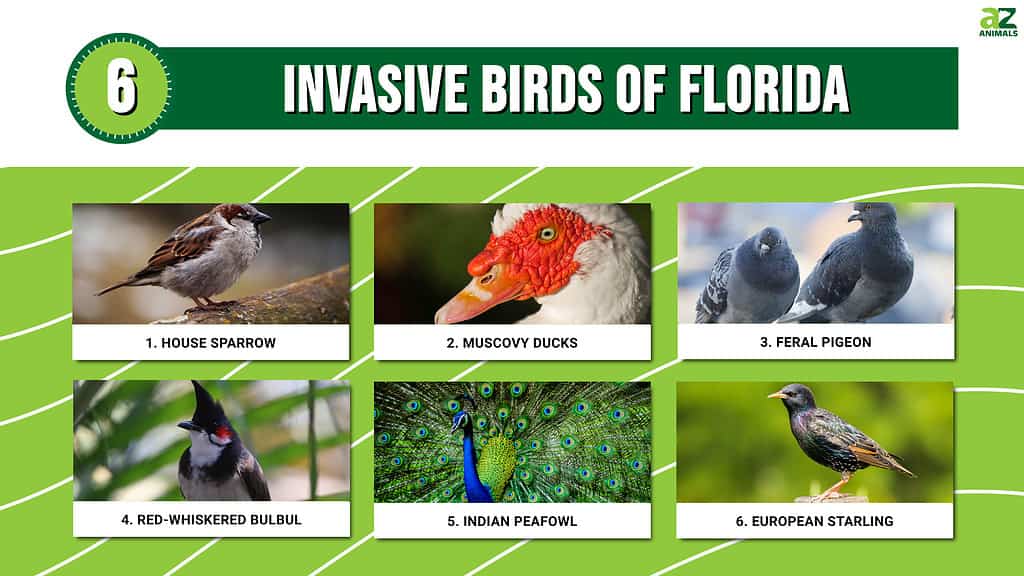
©
Not all animals or plants are beneficial, and it is even more disturbing if they cause more harm than good, like the invasive birds of Florida. Unfortunately, Florida skies are not spared as they have a few invasive bird species. Invasive species of plants and animals become a problem when they cause stressful competition and destroy natural habitats.
Below are six of the most invasive birds in Florida.
The Most Invasive Birds of Florida
1. The House Sparrow
The house sparrow is a small bird measuring approximately 16 cm in size and a maximum of 39.5 grams. The birds have different colors, with females being brown and gray and males having bright black with white markings on their bodies.
Origin
The house sparrow’s scientific name is Passer domesticus. The bird comes from the Passeridae family and is one of the most common birds globally but is native to Europe, Asia, and the Mediterranean basin. The birds were introduced to the rest of the world and are now found in other parts, including the Americas, Africa, and Australia, making them one of the most distributed birds in the world.
Why Are These Birds Considered Invasive?
The bird’s ability to thrive and survive in diverse environments contributes to its widespread. The birds are linked to human habitation and tend to live in rural and urban settings. However, these birds stay away from areas like grasslands, woodlands, and deserts where there is little to no human development.
The bird is an opportunistic eater and mainly feeds on pests, insects, weeds, and seeds. These birds are highly prolific and cause no concern as far as endangerment. So how are they destructive or invasive?
Most people consider the house sparrow an unwanted guest in their backyards and farms. These birds can destroy seed crops such as millet, sorghum, sunflower, and corn.
Interesting Facts About House Sparrows
- House sparrows are destructive as they pierce flowers and drain nectar from them, thus discouraging pollinators like bees from pollinating plants.
- House sparrows aggressively defend their nests. They are even known to evict other birds from their nests, with their biggest culprits being the Purple Martins, Eastern Bluebirds, and Tree Swallows.
- House sparrows prefer artificial structures to nest in as opposed to natural trees. This explains why they are mostly found on walls, nest boxes, street lights, and other structures around the human habitat.
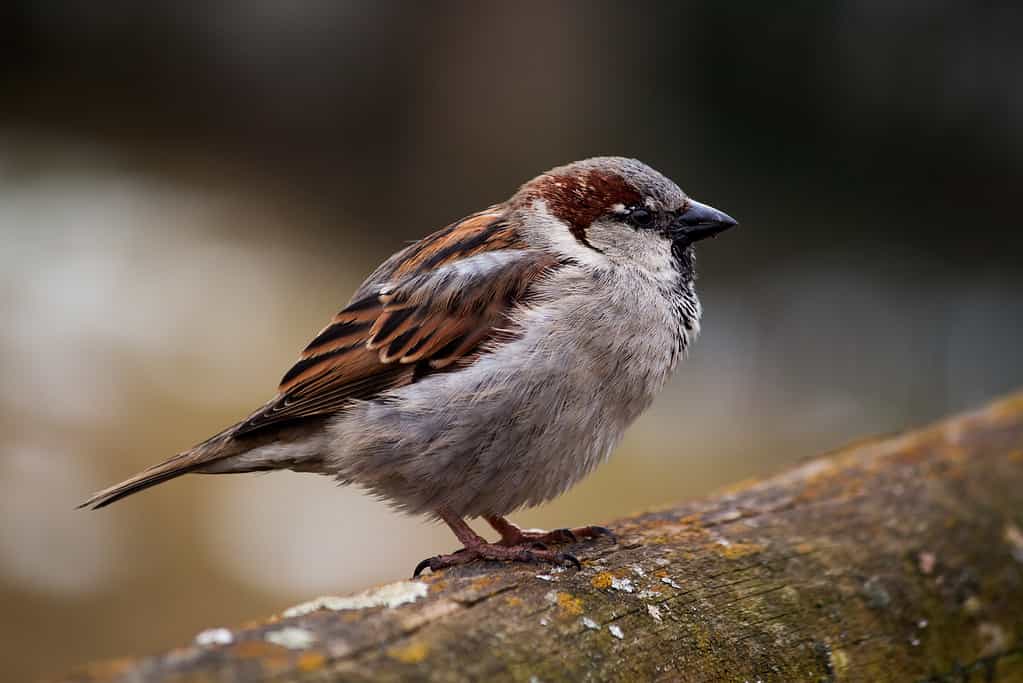
House sparrow (
Passer domesticus).
©iStock.com/Vronja_Photon
2. Muscovy Ducks
The Muscovy duck is a large duck/ bird native to the Americas. It goes by the scientific name Cairina Moschata. It can be found in most places, from the Texas Rio Grande Valley to the areas of Mexico, south of Uruguay, and Argentina. Generally, this is one of the most common ducks in the area.
However, these birds’ smaller and wild versions have also taken over some parts of America, especially in Florida, Massachusetts, and Louisiana. The feral Muscovy can also be found in Hawaii and North America. Beyond America, these birds are also found in Australia, New Zealand, and some parts of Europe.
Features of Muscovy Ducks
The ducks are quite large, with males being 76 cm long and weighing an average of 7kgs. Females are smaller in size and weigh about 3 kg. The colors range from white to black, with yellow and red parts for both males and females.
While this bird thrives in tropical climates, it also does well in colder climates. Bird watchers are often confused by these warty-faced birds. Despite being commonly seen and very distinct, they do not appear in all fields. The typical wild muscovy duck has a glossy black color with bold white patches on the wing. They are generally forest birds that love to nest in the cavities of trees.
They increased in number and became part of Texas in the 1980s. Larger populations of feral Muscovy can be found in Florida.
Exciting Facts About Muscovy Ducks
- Wild Muscovy Ducks have strong claws that help them perch on tall trees since they make their nests on cavities of mature trees.
- Male muscovy ducks are the largest type of bird in North America, although the females are half the size.
- The muscovy duck is the oldest fowl ever to be domesticated and was first kept by Peru and Paraguay people after the influence of Spanish explorers.
The birds do not make a lot of noise hence considered the quietest birds around. The males hiss while females make a weak quack occasionally.
Why Are These Birds Considered Invasive?
On their own and in the wild, Muscovy ducks are not problematic at all. However, they can be a significant issue when introduced in modern areas for ornamental purposes.
Since they appear in large numbers and are highly prolific, they often quickly cause controversy among neighbors. They not only compete with native species in the area but can easily cause property destruction and easily transmit diseases. This is why the U.S. Fish and Wildlife Service revised the rules regarding muscovy ducks.
While one is not required to have a permit to own Muscovy ducks in Florida, one needs to stick to Florida Statute 379.231 as well as the federal regulations 50 CFR 21.25(b)(8) (i), which prohibits the release of the Muscovy ducks.
This means that they must be kept in captivity status and never get into contact with native wildlife or escape their captivity.
Since these ducks can potentially spread diseases and infections to native wildfowl, they are undesirable or the best to have around, especially in Florida.
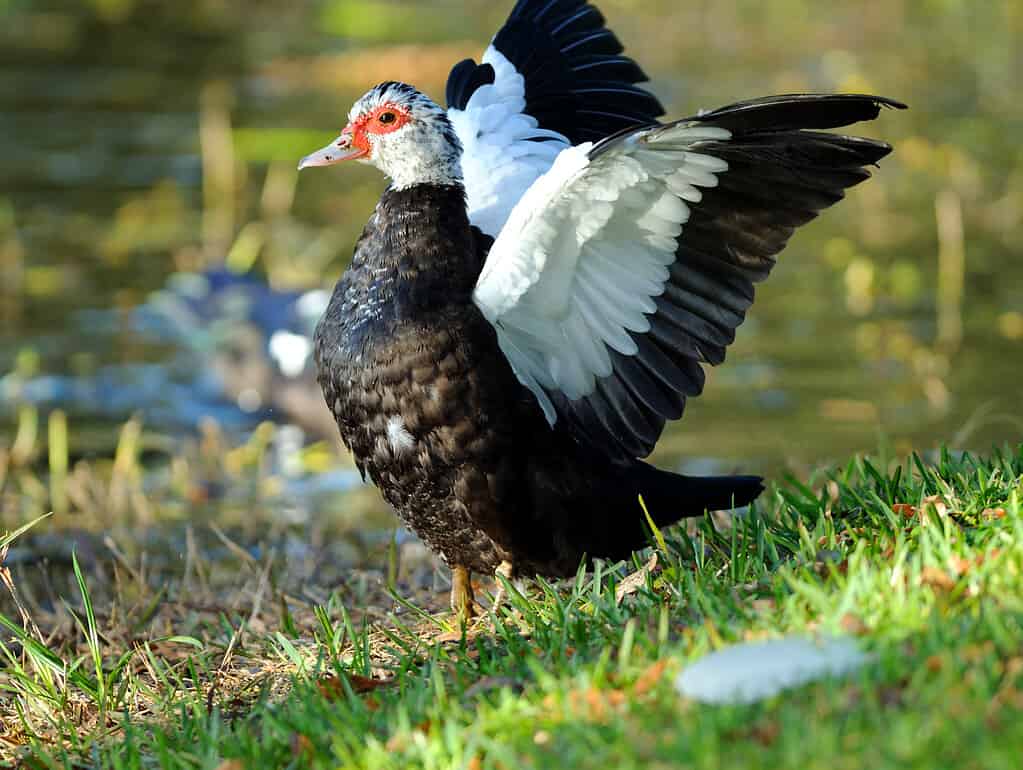
Muscovy duck (
Cairina moschata).
©Bill Ragan/Shutterstock.com
3. Feral Pigeon
The feral pigeon goes by the scientific name Columba livia domestica /Columba livia forma urbana. Feral pigeons are known as city pigeons, city doves, and street pigeons, which are more common in urban areas. These are relatives of the domesticated pigeons that returned to the wild.
Domesticated pigeons were initially bred from mountain rock doves, meaning that Rock, domestic, and feral pigeons are all related since they are all of the same species.
Origin
These birds are not native to the Americas. They were first introduced to the region by European settlers who brought them as a food source and for religious purposes in the 17th century.
The general appearance of these feral pigeons is dark bluish to gray color, especially on the head, chest, and neck. They have glossy greenish, yellowish, and sometimes red-purple colors around the neck and wing feathers.
They arrived in North America with European settlers in the 17th century for food and religious purposes. The birds can live for 3 to 5 years in the wild, within which they can cause severe damage.
However, captive pigeons are known to live up to 15- 35 years
Feral pigeons make their nests in different places, including seaside cliffs and rocks, old farm buildings, bridges, grain elevators, and skyscraper buildings.
Why Are These Birds Considered Invasive?
Although generally harmless in singles, they become a big menace when in large numbers, which is how they mostly are. They tend to create huge mounds of fecal matter that significantly cause disease and infection, thus affecting humans and animals alike.
Feral pigeons also tend to damage property with their waste, as some prefer living on roofs and attics of buildings. They also can cause damage to statues and monuments that are expensive to put up and maintain. They also cause crop damage and are a general nuisance, hence the name rats with wings. This nature of the doves makes them invasive and undesirable.
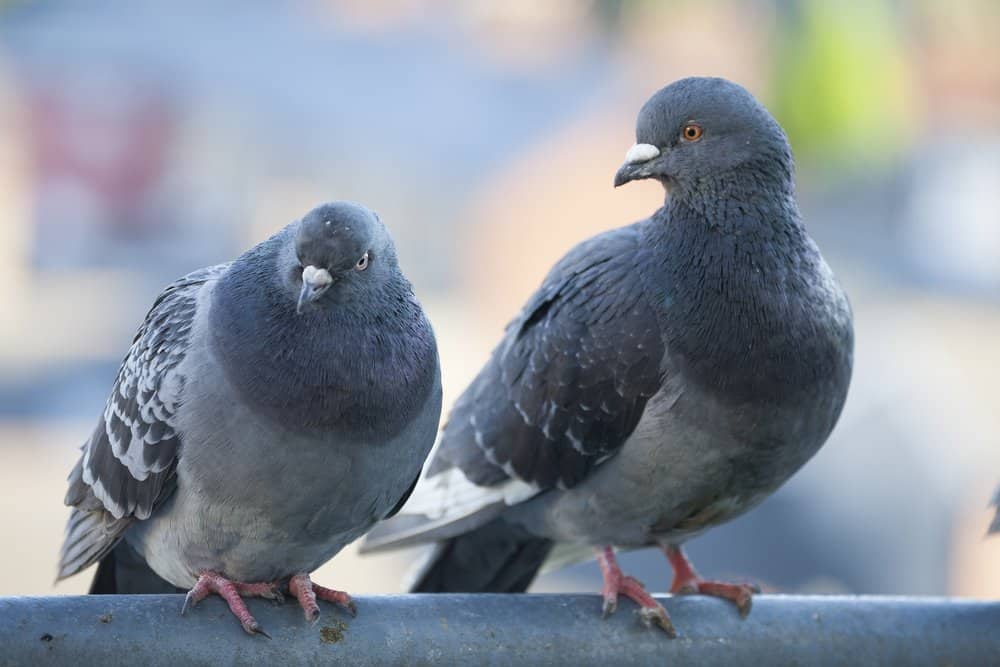
Feral pigeon (
Columba livia domestica/Columba livia forma urbana).
©Julie A Lynch/Shutterstock.com
4. Red-whiskered Bulbul
The red-whiskered bulbul or the crested bulbul goes by the scientific name Pycnonotus jocosus. It belongs to the bulbul bird family and is native to Asia. The bird has been introduced to many tropical regions where it has established itself.
A 3-4 note call bird typically feeds on small insects and fruits. It is a common bird found in modern gardens and hill forests.
Features of Red-whiskered Bulbul
The bird is small, measuring 20 centimeters or 7.9 inches long. The birds can live for up to 11 years and are not easy to miss because of their distinct features. However, these birds are often heard before they are seen because of how loud they get.
The birds are brown on the upper sides and white on their underparts. They have buff flanks with dark spurs that run onto the breast to the shoulder level. They have pointed black crests with red face patches together with black-colored moustachial lines.
The birds have long tails with brown and white terminal feather tips, although they have red vent areas. The juvenile birds will not have the red patch close to the eye and tend to have orangish vent areas.
Why Are These Birds Considered Invasive?
So why are these birds considered invasive in Florida? The behavior of being destructive to fruits can be a major nuisance. They also have been found to have some avian malaria parasites. In 1993, the bird hosted the Plasmodium jianhi in Southeast China.
The state of Florida lists the red-whiskered bulbul as one of the species it prohibits. Therefore, owners need to acquire personal permits to have these birds. This applies to public exhibitors, licensed dealers, and researchers who must meet biosecurity measures and specific criteria to keep the birds.
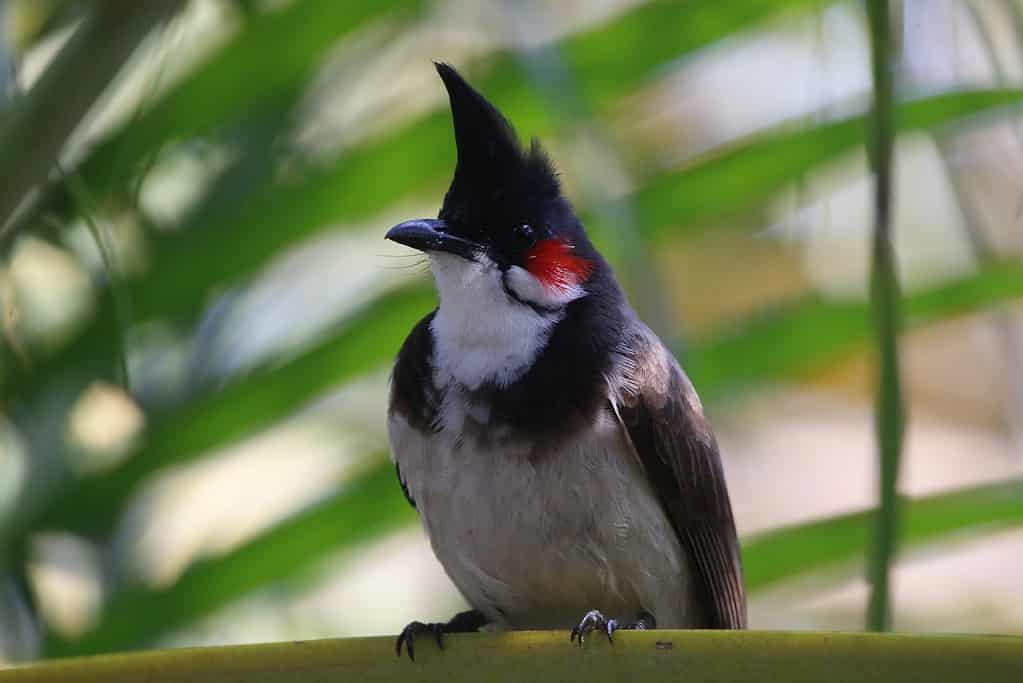
Red-whiskered bulbul (
Pycnonotus jocosus).
©Paulose NK/Shutterstock.com
5. Indian peafowl
The Indian peafowl, the common peacock, or the blue peafowl known in Florida, goes by the scientific name Pavo cristatus.
Origin
The bird is not native to the U.S. despite being available in Florida in large numbers. Its descent is traced back to central Africa, India, and Southeast Asia regions.
However, it has since been introduced to other areas of the world. The peafowls are large beautiful birds that were majorly kept for their aesthetics. However, they also signify different things based on the owner.
Why Are These Birds Considered Invasive?
The peacocks of Florida multiply immensely. All it takes is for a few birds to escape, and they soon become a menace. They are problematic in Florida because they invade front yards and cause a lot of noise as they squeak, even in the middle of the night.
Their feathers also tend to clog drains and ACs. The birds also scratch cars and may attack dogs when in large numbers. Their droppings also cause diseases, especially among kids, as they can be found everywhere in the compounds they invade, including the pool.
Although these birds are not endangered, they are protected by Florida authorities. As such, they tend to multiply quickly, and efforts to control their populations are not fruitful.
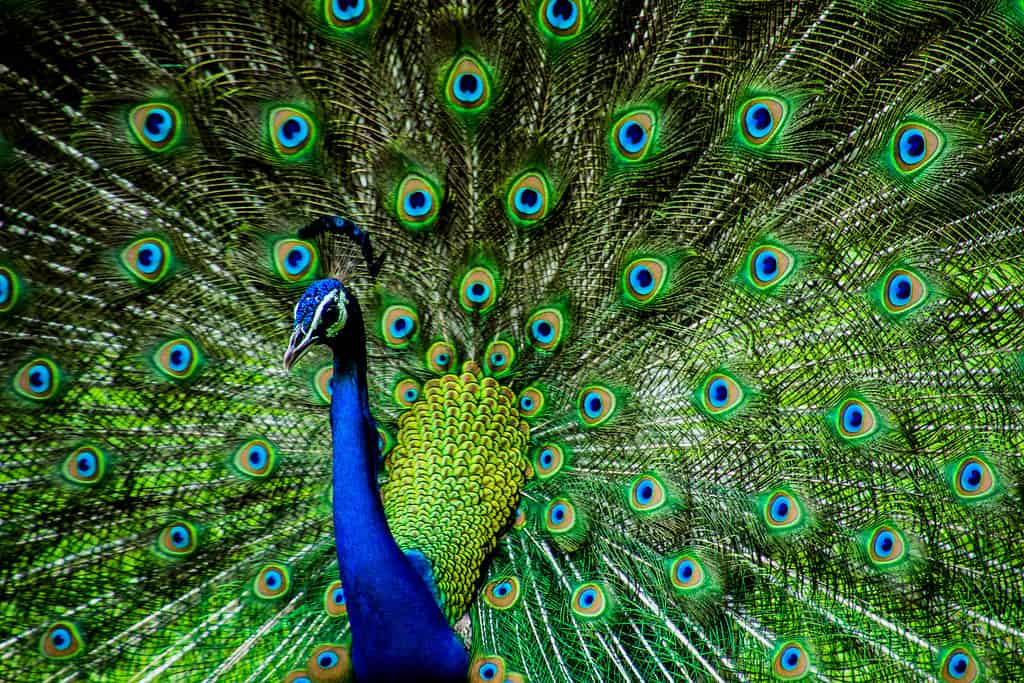
Common peacock or Indian peafowl (
Pavo cristatus).
©Kandarp/Shutterstock.com
6. The European Starling
These invasive birds of Florida go by the name common starling and the scientific name Sturnus vulgaris. It is a small-sized bird measuring about 20 cm long and has glossy black plumage and an almost metallic sheen with white speckles.
Features of the European Starling
The bird has pink legs and is a generally noisy bird. These birds move in flocks and can benefit farmers when they eat insects and pests on the farm or be destructive when they consume fruits and seeds from the farmer’s property.
Why Are These Birds Considered Invasive?
The large numbers are also bad for urban populations as they tend to be noisy and cause a lot of mess wherever they live. They also tend to compete for resources with other native bids.
Starlings steal other birds’ nests, water, and food. While these birds are reducing in numbers in Europe due to the declining grassland, their overall world population seems to be at an all-time high as they migrate for better conditions.
The invasive birds of Florida are a nuisance to the environment and the residents. These birds affect the residents of Florida either directly or indirectly. One thing is clear, though, it is essential to control the populations of these invasive species to protect the native species they compete with.
It is the authorities’ responsibility to ensure such control, and owners of these invasive species of birds keep them away from the indigenous species or the people around them.
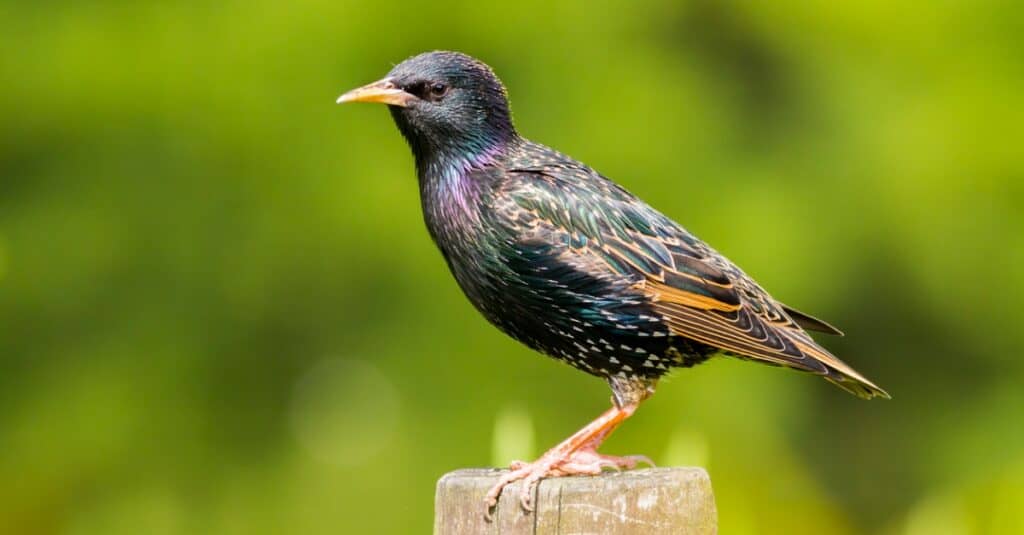
European starling (
Sturnus vulgaris).
©iStock.com/chris2766
Summary of 6 Invasive Birds of Florida
| # | Bird | Invasive Behavior |
|---|---|---|
| 1 | House Sparrow | Eat crops |
| 2 | Muscovy Ducks | When introduced for ornamental purposes, can cause destruction and compete with native birds |
| 3 | Feral Pigeon | Become a menace in large numbers by producing mounds of fecal material |
| 4 | Red-whiskered Bulbul | Destructive to fruits and carry avian malarial parasites |
| 5 | Indian peafowl | In large numbers, they are loud, aggressive, and spread bacteria |
| 6 | European Starling | Steal nests and compete with native birds, noisy and messy |
The photo featured at the top of this post is © Ezaz ahmed Evan/Shutterstock.com
Thank you for reading! Have some feedback for us? Contact the AZ Animals editorial team.







